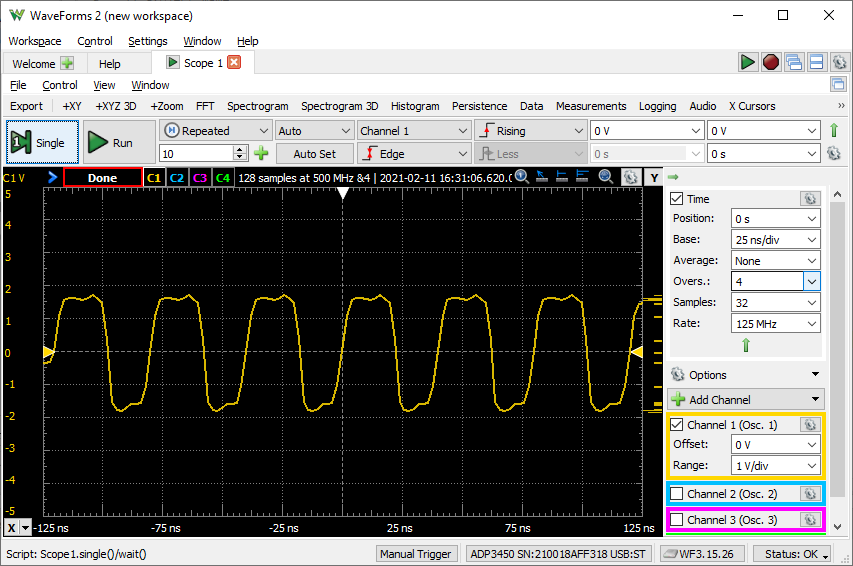Sampling a Signal at 0.5 GS/s with the Analog Discovery Pro (ADP3450/ADP3250)
This guide discusses how to achieve the highest sampling rates that the Analog Discovery Pro can reach. By combining 4x oversampling with the maximum sample rate of 125 MS/s, a sample rate of 0.5 GS/s can be achieved.
Inventory
You will need your Analog Discovery Pro, a computer with the WaveForms application installed, and some signal to measure. It should be noted that the Analog Discovery Pro's Waveform Generator specifications do not allow the device to generate a signal for which oversampling would meaningfully improve the acquisition.
What is Oversampling?
- Click Here for a Brief Overview of Oversampling
-
An oscilloscope is used to take repeated acquisitions of the same signal, capturing the same section of the same wave multiple times in a row. Each acquisition is taken at a different phase. When these captures are superimposed, they combine into a data set with a higher sample rate than any of the individual captures could have provided on its own.
The Analog Discovery Pro (ADP3450/ADP3250) performs these captures using a single oscilloscope channel, by taking successive captures on the same trigger. This means that it requires the captured signal to be consistent and repeating. While the ADP3450/ADP3250 supports oversampling factors greater than 4x, with these factors the effective sample rate exceeds the device bandwidth, and little new information about the captured signal can be found.
Guide
|
Make sure the Analog Discovery Pro (ADP3450/ADP3250) is connected, plugged in, and powered on. Launch WaveForms and open the device manager. If WaveForms is already open, the device manager can be opened either through the Settings menu, or by clicking on the device indicator at the bottom of the window. |
|
The system sample rate can be changed by opening the Options dropdown while the Analog Discovery Pro device is selected in the list of devices. By changing the selection in the “Frequency” dropdown, the sample rate is changed. By increasing the system's sample rate in this way, the Waveform Generator, Oscilloscope, Logic Analyzer, Pattern Generator, and others, are made able to take in or put out samples at a rate of up to 125 MHz. Note: Changing the system sample rate changes the set of sample rates that can be achieved by the Analog Discovery Pro's Digital I/O pins. Achievable rates with either selection are integer divisions of the system sample rate. For example, a 62.5 MS/s sample rate is achievable in the Logic Analyzer when the frequency is set to 125 MHz, but not when the frequency is 100 MHz. |
|
Close the device manager by clicking Select. Next, open the Oscilloscope instrument. Note: The waveform generator should not be used in a loopback configuration to test oversampling, as the two instruments are synchronous to each other. This is unlike some other guides, where the precise timing of the input and output do not matter for demonstration purposes. |
|
Found in the time configuration pane, the “Overs.” dropdown is used to set the oversampling factor, set it to 4. Make sure to set the “Rate:” dropdown to 125 MHz. Note: While they appear in the dropdown, oversampling factors greater than 4x are unnecessary, since, due to the bandwidth of the oscilloscope inputs, any signal that could only be measured at these rates is highly attenuated. |
The use of a trigger is necessary to get the Analog Discovery Pro's oversampling working properly. This is because the device takes multiple repeated acquisitions in order to construct the oversampled capture. If the individual acquisitions do not align as well as possible, significant additional noise can be introduced.
See below for a simple trigger setup. Whenever Channel 1 rises above zero volts, the trigger fires. Note that the trigger source must correspond to the channel you are using - Channel 1 in the example.
The best trigger conditions to use heavily depend on the signal being acquired. For more information on the use of triggers, refer to the Using External Triggers and Using Cross Triggering guides.
|
Finally, you can check the sample rate and number of samples indicators to see the settings used for the capture currently displayed on the plot pane. “2048 samples at 500 MHz &4” means that the combined oversampled capture has 2048 total samples, a sample rate of 500 MS/s (0.5 GS/s), and consists of four individual captures. This capture was taken with an oversampling factor of 4, 512 samples per capture, and at a 125 MS/s sample rate. |
Below, you can see an example of the effect that oversampling has. A 25 MHz clock signal (0 to 3.3 V square wave) was captured first using no oversampling, then an oversampling factor of 4x.
|
|
|
Other Resources
Check the Analog Discovery Pro (ADP3450/ADP3250) Resource Center for more guides on using your device.
For more information on the Oscilloscope instrument, refer to Using the Oscilloscope









